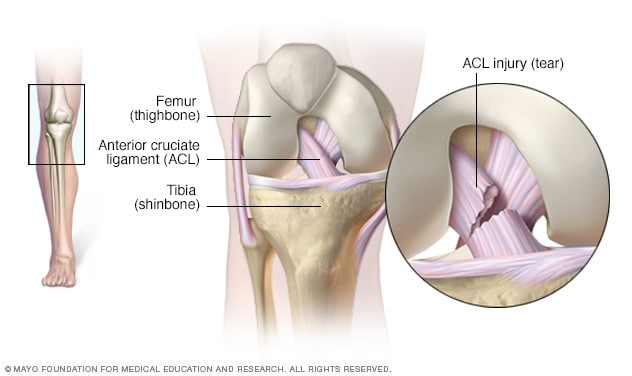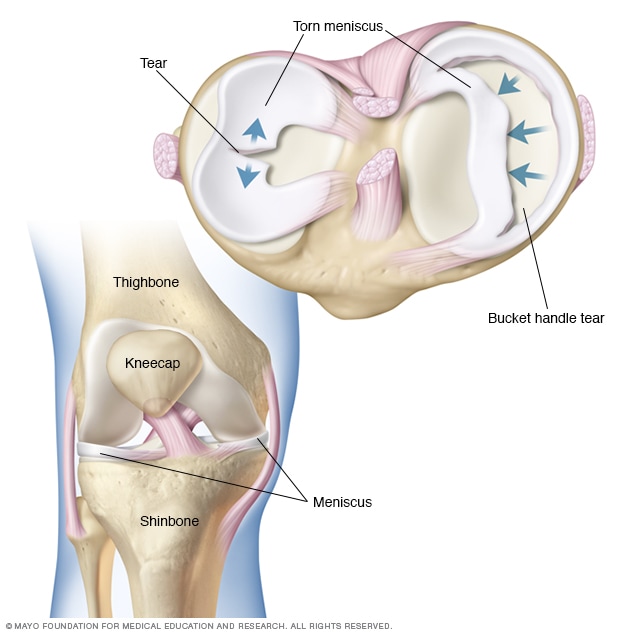Knee pain
Symptoms & causes
Diagnosis & treatment
Doctors & departments
Overview
Knee pain is a common complaint that affects people of all ages. Knee pain may be the result of an injury, such as a ruptured ligament or torn cartilage. Medical conditions — including arthritis, gout and infections — also can cause knee pain.
Many types of minor knee pain respond well to self-care measures. Physical therapy and knee braces also can help relieve pain. In some cases, however, your knee may require surgical repair.
Symptoms
The location and severity of knee pain may vary, depending on the cause of the problem. Signs and symptoms that sometimes accompany knee pain include:
Swelling and stiffness
Redness and warmth to the touch
Weakness or instability
Popping or crunching noises
Inability to fully straighten the knee
When to see a doctor
Call your doctor if you:
Can't bear weight on your knee or feel as if your knee is unstable or gives out
Have marked knee swelling
Are unable to fully extend or flex your knee
See an obvious deformity in your leg or knee
Have a fever, in addition to redness, pain and swelling in your knee
Have severe knee pain that is associated with an injury
Causes
Knee pain can be caused by injuries, mechanical problems, types of arthritis and other problems.
Injuries
 ACL injuryOpen pop-up dialog box
ACL injuryOpen pop-up dialog box
A knee injury can affect any of the ligaments, tendons or fluid-filled sacs (bursae) that surround your knee joint as well as the bones, cartilage and ligaments that form the joint itself. Some of the more common knee injuries include:
ACL injury. An ACL injury is a tear of the anterior cruciate ligament (ACL) — one of four ligaments that connect your shinbone to your thighbone. An ACL injury is particularly common in people who play basketball, soccer or other sports that require sudden changes in direction.
Fractures. The bones of the knee, including the kneecap (patella), can be broken during falls or auto accidents. Also, people whose bones have been weakened by osteoporosis can sometimes sustain a knee fracture simply by stepping wrong.
Torn meniscus. The meniscus is the tough, rubbery cartilage that acts as a shock absorber between your shinbone and thighbone. It can be torn if you suddenly twist your knee while bearing weight on it.
Knee bursitis. Some knee injuries cause inflammation in the bursae, the small sacs of fluid that cushion the outside of your knee joint so that tendons and ligaments glide smoothly over the joint.
Patellar tendinitis. Tendinitis causes irritation and inflammation of one or more tendons — the thick, fibrous tissues that attach muscles to bones. This inflammation can happen when there's an injury to the patellar tendon, which runs from the kneecap (patella) to the shinbone and allows you to kick, run and jump. Runners, skiers, cyclists, and those involved in jumping sports and activities may develop patellar tendinitis.
Mechanical problems
Some examples of mechanical problems that can cause knee pain include:
Loose body. Sometimes injury or degeneration of bone or cartilage can cause a piece of bone or cartilage to break off and float in the joint space. This may not create any problems unless the loose body interferes with knee joint movement, in which case the effect is something like a pencil caught in a door hinge.
Iliotibial band syndrome. This occurs when the tough band of tissue that extends from the outside of your hip to the outside of your knee (iliotibial band) becomes so tight that it rubs against the outer portion of your thighbone. Distance runners and cyclists are especially susceptible to iliotibial band syndrome.
Dislocated kneecap. This occurs when the triangular bone that covers the front of your knee (patella) slips out of place, usually to the outside of your knee. In some cases, the kneecap may stay displaced and you'll be able to see the dislocation.
Hip or foot pain. If you have hip or foot pain, you may change the way you walk to spare your painful joint. But this altered gait can place more stress on your knee joint and cause knee pain.
Types of arthritis
More than 100 different types of arthritis exist. The varieties most likely to affect the knee include:
Osteoarthritis. Sometimes called degenerative arthritis, osteoarthritis is the most common type of arthritis. It's a wear-and-tear condition that occurs when the cartilage in your knee deteriorates with use and age.
Rheumatoid arthritis. The most debilitating form of arthritis, rheumatoid arthritis is an autoimmune condition that can affect almost any joint in your body, including your knees. Although rheumatoid arthritis is a chronic disease, it tends to vary in severity and may even come and go.
Gout. This type of arthritis occurs when uric acid crystals build up in the joint. While gout most commonly affects the big toe, it can also occur in the knee.
Pseudogout. Often mistaken for gout, pseudogout is caused by calcium-containing crystals that develop in the joint fluid. Knees are the most common joint affected by pseudogout.
Septic arthritis. Sometimes your knee joint can become infected, leading to swelling, pain and redness. Septic arthritis often occurs with a fever, and there's usually no trauma before the onset of pain. Septic arthritis can quickly cause extensive damage to the knee cartilage. If you have knee pain with any of the symptoms of septic arthritis, see your doctor right away.
Other problems
Patellofemoral pain syndrome is a general term that refers to pain arising between the kneecap and the underlying thighbone. It's common in athletes; in young adults, especially those whose kneecap doesn't track properly in its groove; and in older adults, who usually develop the condition as a result of arthritis of the kneecap.
Risk factors
A number of factors can increase your risk of having knee problems, including:
Excess weight. Being overweight or obese increases stress on your knee joints, even during ordinary activities such as walking or going up and down stairs. It also puts you at increased risk of osteoarthritis by accelerating the breakdown of joint cartilage.
Lack of muscle flexibility or strength. A lack of strength and flexibility can increase the risk of knee injuries. Strong muscles help stabilize and protect your joints, and muscle flexibility can help you achieve full range of motion.
Certain sports or occupations. Some sports put greater stress on your knees than do others. Alpine skiing with its rigid ski boots and potential for falls, basketball's jumps and pivots, and the repeated pounding your knees take when you run or jog all increase your risk of knee injury. Jobs that require repetitive stress on the knees such as construction or farming also can increase your risk.
Previous injury. Having a previous knee injury makes it more likely that you'll injure your knee again.
Complications
Not all knee pain is serious. But some knee injuries and medical conditions, such as osteoarthritis, can lead to increasing pain, joint damage and disability if left untreated. And having a knee injury — even a minor one — makes it more likely that you'll have similar injuries in the future.
Prevention
Although it's not always possible to prevent knee pain, the following suggestions may help ward off injuries and joint deterioration:
Keep extra pounds off. Maintain a healthy weight; it's one of the best things you can do for your knees. Every extra pound puts additional strain on your joints, increasing the risk of injuries and osteoarthritis.
Be in shape to play your sport. To prepare your muscles for the demands of sports participation, take time for conditioning.
Practice perfectly. Make sure the technique and movement patterns you use in your sports or activity are the best they can be. Lessons from a professional can be very helpful.
Get strong, stay flexible. Weak muscles are a leading cause of knee injuries. You'll benefit from building up your quadriceps and hamstrings, the muscles on the front and back of your thighs that help support your knees. Balance and stability training helps the muscles around your knees work together more effectively.
And because tight muscles also can contribute to injury, stretching is important. Try to include flexibility exercises in your workouts.
Be smart about exercise. If you have osteoarthritis, chronic knee pain or recurring injuries, you may need to change the way you exercise. Consider switching to swimming, water aerobics or other low-impact activities — at least for a few days a week. Sometimes simply limiting high-impact activities will provide relief.
The Mayo Clinic experience and patient stories
Our patients tell us that the quality of their interactions, our attention to detail and the efficiency of their visits mean health care like they've never experienced. See the stories of satisfied Mayo Clinic patients.

Orthopedic Surgery at Mayo Clinic Ends Nurse's Hip and Knee Pain
Jesse Stewart with Bruce DeGrote Jesse Stewart couldn't understand why the seven orthopedic surgeries he'd had for pain in one knee and both hips hadn't done anything to improve his quality of life. After coming to Mayo Clinic, however, Jesse found the answer to that question, and he finally received surgery that fixed the problems. [...]

Restored Knee Function Transforms a Life, Inspires Family to Give Back
The Reibels have relied on Mayo Clinic for their care for 25 years. That experience has inspired them to donate to Mayo Clinic's Center for Regenerative Medicine. Even in retirement, Dr. and Mrs. Reibel -- or Jay and Barbara as their friends at Mayo Clinic have come to know them -- are always on the go. They [...]
By Mayo Clinic Staff
Request an Appointment at Mayo Clinic
Diagnosis & treatment
May 11, 2021
Related
Hyperextended knee: Cause of serious injury?
Products & Services
Book: Mayo Clinic Guide to Pain ReliefShow more products and services from Mayo Clinic
Knee pain
Symptoms & causes
Diagnosis & treatment
Doctors & departments

